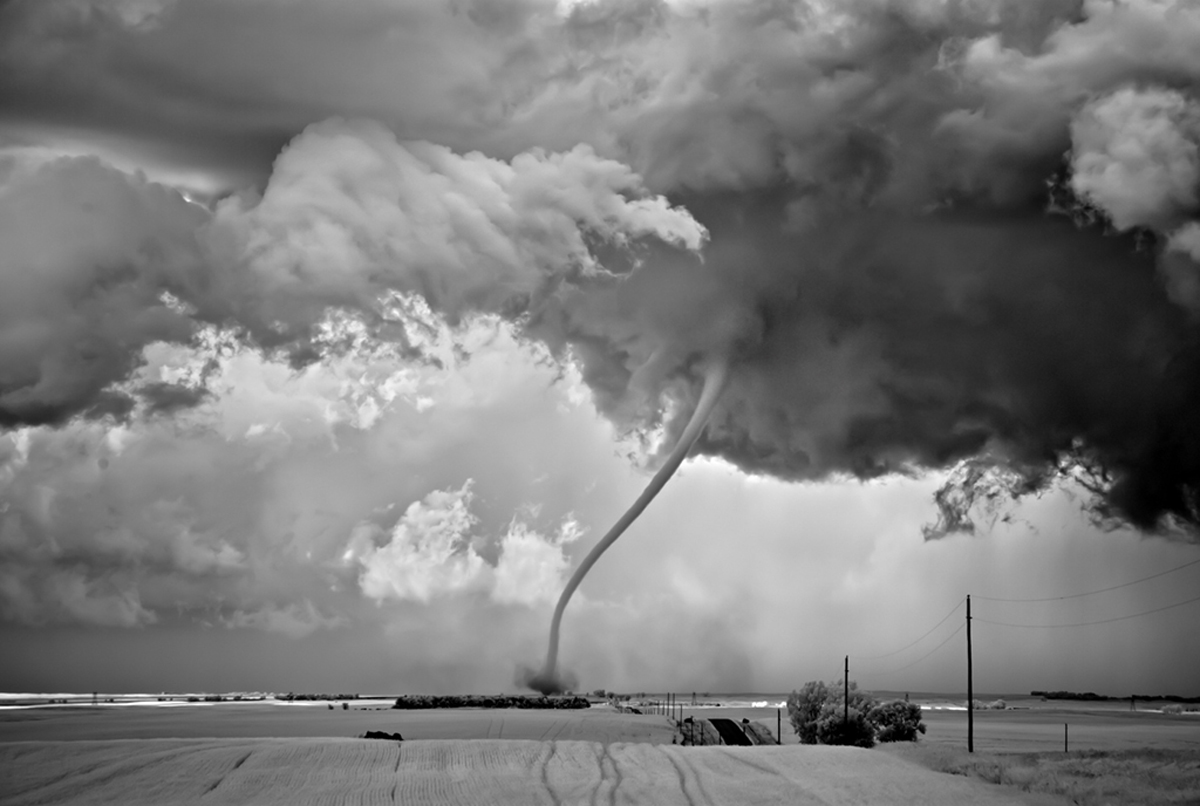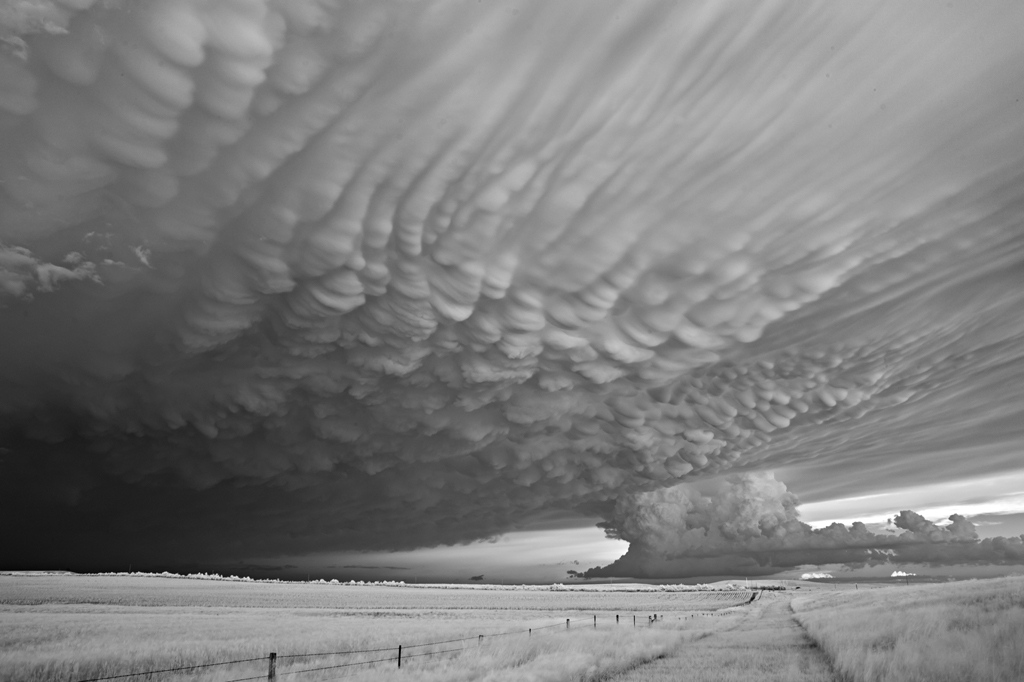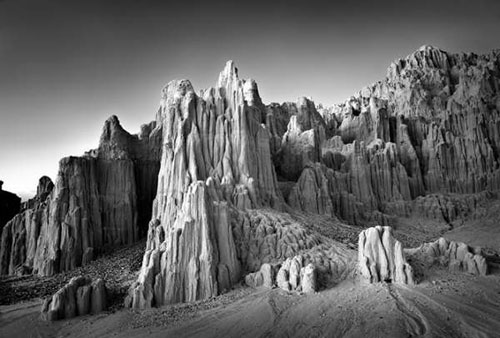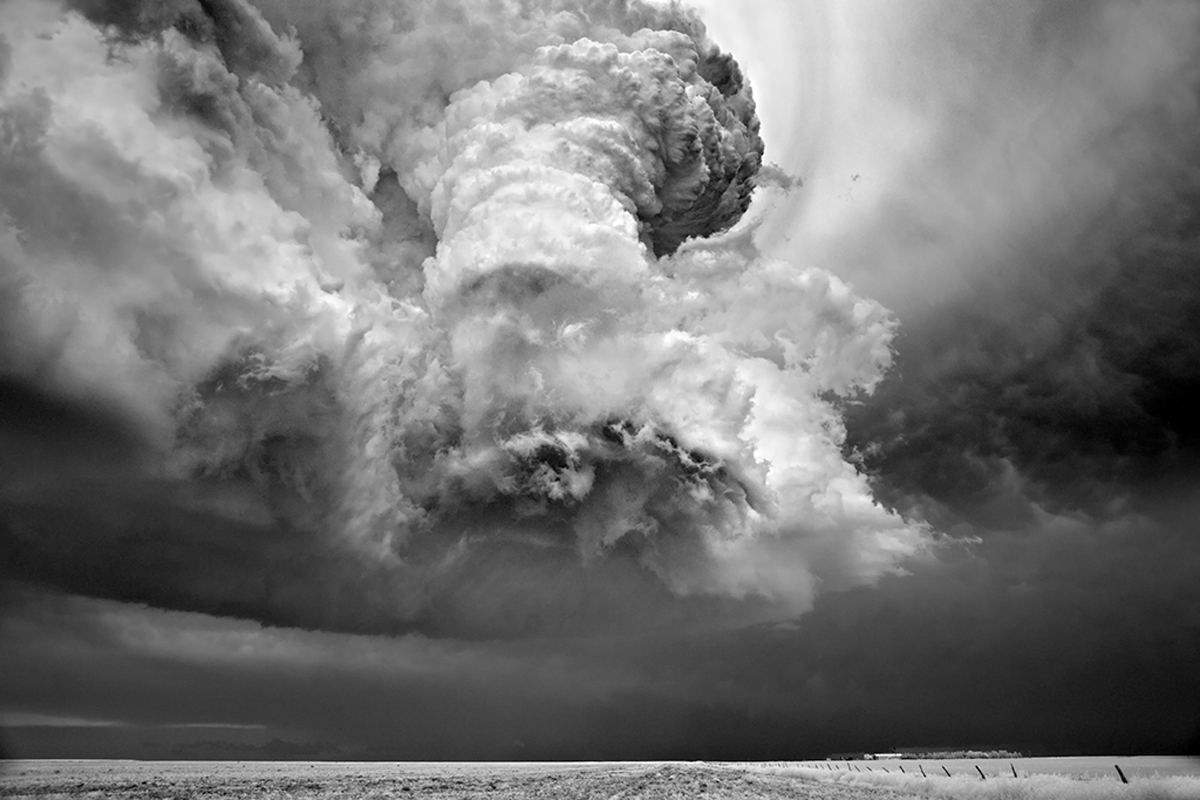Jessica Stewart recently interviewed gallery artist Mitch Dobrowner for My Modern Net. Click here to view the full article.
Storm Photographer Captures Raw Elegance and Unpredictable Power of Mother Nature [Interview]
by Jessica Stewart, August 26, 2021
Rope Out, Regan, North Dakota, 2011
For fine art photographer Mitch Dobrowner, nature is the ultimate muse. Inspired by the great landscape photographers of the past—from Ansel Adams to Minor White—Dobrowner crisscrosses the United States chasing down storms and memorable landscapes. By shooting in black and white, Dobrowner's images take on a classical feel that allows viewers to focus on the powerful shapes that nature creates.
Incredibly, after spending much of his early life immersed in photography, Dobrowner put his camera down as the responsibilities of raising a family took over. Luckily, about 15 years ago, he was inspired once again to pursue his passion and has become an award-winning landscape photographer. Particularly known for his storm chasing photos, his dedication to fine art photography has distinguished him from others in the field.
Mammatus, Bolton, Kansas, 2016
You've mentioned before that Ansel Adams was a big inspiration. What lessons of his do you try to instill in your own work?
The first time I picked up a camera I was 17; I quickly became addicted. As I was searching for who I was and what photography was all about, I eventually stumbled onto the images of both Ansel Adams and Minor White. They were the ones that inspired me in my late teens. I had never been exposed to photographic images such as theirs before then.
The first time I saw their work I was floored…it was at the Museum of Modern Art in New York City. It may sound a bit cliche, but the images left a major mark on my life. Their work was mind-boggling to me. Ansel was all about light, composition, making order out of disorder, being in touch with the environment while addressing all the technical aspects of photography. Ansel’s books The Camera, The Print, and The Negative became my bibles. And even today, when I look at a great Ansel Adams print or book, my world turns upside down.
Minor White's images were all about using light and shadow in compositions. I became infused with his images and because of that, I began experimenting with surreal abstract forms and closely watching how light would move across an environment. There will never be another Ansel Adams. There will never be another Minor White. I owe much to these great photographers of the past, especially Ansel Adams, for their dedication to the craft. Their dedication, determination, craftsmanship, and vision still inspire me. Though I have never met them, they helped me determine the course my life would take.
Hoodoo, 2007
Is that where the stylistic choice to shoot in black and white comes from or did something else motivate that choice?
It's pretty simple—black and white interprets reality in a way that I “see” as a photographer. My wife, who is a designer and painter, always teases me and says I’m color blind. But I’m not–I just know the names of all the colors. How do you describe terracotta if you don’t know the name of that color? And the only time I see in color is when I’m listening to music. I see music/orchestrations in their various tones. Not sure why…but it's what I see.
Color work also seems too realistic and “every day” to me. It’s what I see every time I look around, so it's boring to me. I also get bombarded with color imagery, whether it’s over the internet, on TV, billboards, movies, magazines, etc. I’m pretty visual, so most of it just leads to sensory overload. So I decided to leave color photography to the great color photographers out there. I also see black and white prints as my final vision, the final product. The JPGs on the internet are only a proxy of that final vision. As an artist, I love the aesthetic and technical challenges of generating museum-quality black and white printing.
Arm of God, 2009
Many people have heard of storm chasing but aren't really sure how it works. What sort of research goes into finding these storms? I imagine you have to be ready to pick up and go at a moment's notice.
In terms of finding storms, when on the road there is a combination of hardware tools and applications that Roger Hill, my friend and guide, will use. Most of the software uses NOAA/Doppler data as a means for tracking what’s happening within a storm. There are also weather forecasting models that can be accessed.
In regards to photographing the storms, it's kind of a hybrid between shooting a quiet landscape and a sporting event. Compositions are constantly changing, the light is changing, there’s wind, there’s noise, there’s a lot going on and you have to stay focused. Sometimes you drive 500 plus miles and drop your tripod and the perfect composition happens the second you drop it; sometimes nothing happens until half an hour later. Sometimes nothing happens at all. With Roger as my guide, over the past 11 years, I've calculated that we have driven over 70,000 miles chasing storm systems. Sometimes we'll chase every day, sometimes there's nothing going on and we sit for days—it's the ultimate road trip. So I've learned that patience is truly a virtue.
Click here to continue reading.
To view works by Mitch Dobrowner, please visit his artist page.
Jessica Stewart recently interviewed gallery artist Mitch Dobrowner for My Modern Net. Click here to view the full article.
Storm Photographer Captures Raw Elegance and Unpredictable Power of Mother Nature [Interview]
by Jessica Stewart, August 26, 2021
Rope Out, Regan, North Dakota, 2011
For fine art photographer Mitch Dobrowner, nature is the ultimate muse. Inspired by the great landscape photographers of the past—from Ansel Adams to Minor White—Dobrowner crisscrosses the United States chasing down storms and memorable landscapes. By shooting in black and white, Dobrowner's images take on a classical feel that allows viewers to focus on the powerful shapes that nature creates.
Incredibly, after spending much of his early life immersed in photography, Dobrowner put his camera down as the responsibilities of raising a family took over. Luckily, about 15 years ago, he was inspired once again to pursue his passion and has become an award-winning landscape photographer. Particularly known for his storm chasing photos, his dedication to fine art photography has distinguished him from others in the field.
Mammatus, Bolton, Kansas, 2016
You've mentioned before that Ansel Adams was a big inspiration. What lessons of his do you try to instill in your own work?
The first time I picked up a camera I was 17; I quickly became addicted. As I was searching for who I was and what photography was all about, I eventually stumbled onto the images of both Ansel Adams and Minor White. They were the ones that inspired me in my late teens. I had never been exposed to photographic images such as theirs before then.
The first time I saw their work I was floored…it was at the Museum of Modern Art in New York City. It may sound a bit cliche, but the images left a major mark on my life. Their work was mind-boggling to me. Ansel was all about light, composition, making order out of disorder, being in touch with the environment while addressing all the technical aspects of photography. Ansel’s books The Camera, The Print, and The Negative became my bibles. And even today, when I look at a great Ansel Adams print or book, my world turns upside down.
Minor White's images were all about using light and shadow in compositions. I became infused with his images and because of that, I began experimenting with surreal abstract forms and closely watching how light would move across an environment. There will never be another Ansel Adams. There will never be another Minor White. I owe much to these great photographers of the past, especially Ansel Adams, for their dedication to the craft. Their dedication, determination, craftsmanship, and vision still inspire me. Though I have never met them, they helped me determine the course my life would take.
Hoodoo, 2007
Is that where the stylistic choice to shoot in black and white comes from or did something else motivate that choice?
It's pretty simple—black and white interprets reality in a way that I “see” as a photographer. My wife, who is a designer and painter, always teases me and says I’m color blind. But I’m not–I just know the names of all the colors. How do you describe terracotta if you don’t know the name of that color? And the only time I see in color is when I’m listening to music. I see music/orchestrations in their various tones. Not sure why…but it's what I see.
Color work also seems too realistic and “every day” to me. It’s what I see every time I look around, so it's boring to me. I also get bombarded with color imagery, whether it’s over the internet, on TV, billboards, movies, magazines, etc. I’m pretty visual, so most of it just leads to sensory overload. So I decided to leave color photography to the great color photographers out there. I also see black and white prints as my final vision, the final product. The JPGs on the internet are only a proxy of that final vision. As an artist, I love the aesthetic and technical challenges of generating museum-quality black and white printing.
Arm of God, 2009
Many people have heard of storm chasing but aren't really sure how it works. What sort of research goes into finding these storms? I imagine you have to be ready to pick up and go at a moment's notice.
In terms of finding storms, when on the road there is a combination of hardware tools and applications that Roger Hill, my friend and guide, will use. Most of the software uses NOAA/Doppler data as a means for tracking what’s happening within a storm. There are also weather forecasting models that can be accessed.
In regards to photographing the storms, it's kind of a hybrid between shooting a quiet landscape and a sporting event. Compositions are constantly changing, the light is changing, there’s wind, there’s noise, there’s a lot going on and you have to stay focused. Sometimes you drive 500 plus miles and drop your tripod and the perfect composition happens the second you drop it; sometimes nothing happens until half an hour later. Sometimes nothing happens at all. With Roger as my guide, over the past 11 years, I've calculated that we have driven over 70,000 miles chasing storm systems. Sometimes we'll chase every day, sometimes there's nothing going on and we sit for days—it's the ultimate road trip. So I've learned that patience is truly a virtue.
Click here to continue reading.
To view works by Mitch Dobrowner, please visit his artist page.






Comments (0)
Add a Comment